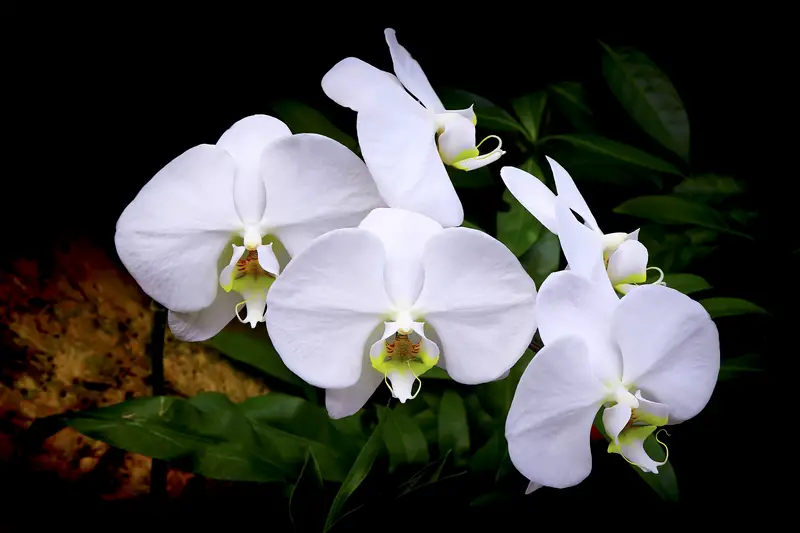Introduction
Waking up on a beautiful morning only to find your orchid leaves browning can be frustrating. All your hard work feels like it’s going down the drain.
So, why is it that your orchid leaves turning brown?
Overwatering is the primary cause of brown leaves in your orchid plant. Sometimes too much fertilizer or too much sunlight can make the leaves turn brown. You must also keep an eye on the temperature and possible infections of the plant.
These were the reasons for orchid leaves browning in a nutshell. However, if you want more information and details of the steps, spare us a minute and read along!
Ready?

What to Do When Orchid Leaves Are Turning Brown?
Orchids are one of the easiest plants to grow in your house. However, some factors might affect these marvelous indoor plants resulting in yellow leaves or brown spots.
Generally, browning leaves aren’t a bother. Because that’s the way of plants to get rid of the old foliage in order to grow new ones. So don’t make a fuss about browning leaves at the bottom of your plants.
The simplest thing to do would be to chop them off with your garden scissors.
Not all garden scissors serve the purpose. So here are some garden scissors we recommend for trimming your indoor plants-
| Product 1 | Felco Pruning Shears |
| Product 2 | VIVOSUN 1-Pack Gardening Hand Pruner Pruning Shear |
| Product 3 | Fiskars 399241-1001 Micro-Tip Pruner |
There’s more-
If the new leaves of your orchid are turning yellow or have brown spots, then you should be worried. You need to put your gardening hat on and get to work quickly.
So here are the reasons and solutions for your orchid leaves turning brown-
Reason 1 of 5: Underwatering
This is one of the prime reasons for orchid leaves turning brown. Lack of water is a common issue for indoor gardeners. That’s because a lot of them don’t spare time for plant care.
Underwatering your plants means reducing your plants’ intake of soil nutrients. Which causes the leaves of the orchid to dry out. As a result, your plant leaves start browning.
Bad news right?
Solution
So what can you do to keep your orchid from underwatering?
We suggest you make a schedule for watering your orchids. Once a week in winter and twice a week in summer is the ideal timeline.
But when you are watering, check the soil in the orchid pot. If it’s dry, feel free to add a little water.
In the worst cases, you might need to repot the orchids.
Reason 2 of 5: Too Much Sunlight
If you’re worried about whether your plant is getting enough sunlight. Don’t think too much! Orchids are tropical by nature and grow peacefully under the shadows of palm trees.
Many gardeners are clueless about the effect of too much sunlight on the plants. And expose their orchids to direct sunlight. For that, you’ll find your orchid leaves browning or scorched.
Solution
To help your orchids recover from harsh sunlight, change their placement.
The ideal placement of an orchid plant is near a north-facing window in winter. And a south-facing window in summer. This will ensure mild indirect sunlight for your orchid.
In case, there are no south or north-facing windows, put a curtain or cover to block the light. After a week or so, your plant might start looking happy!
Reason 3 of 5: Wrong Temperature
Orchids prefer a temperature between the range of 60-80 degrees F. But your plant might’ve gotten exposed to a higher or lower temperature. As a result, the leaves start getting stressed and brown.
Solution
It’s time to get your thermometer to find out if the temperature is within the optimal range. If not then you either change the location. Or try to control the temperature with a room heater or room cooler.
There are some temperature controlling systems for plants out in the market. They are called a grow tent heater. These can help you keep a constant room temperature for your plants.
Some of the recommendable room temperature systems are listed below-
| Product 1 | BN-LINK Digital Heat Mat Thermostat Controller |
| Product 2 | Inkbird ITC-308 Digital Temperature Controller |
| Product 3 | Honeywell Home RCHT8610WF2006/W, T5 Smart Thermostat |
Now that your orchid is thriving at the right temperature. Just sit back and watch the flowers bloom.
Reason 4 of 5: Too Much Fertilizer
Fertilizers are absolutely essential. Sometimes indoor gardeners overdose their plants with too many fertilizers. The reason is that they think indoor plants don’t get access to nutrition like that of outdoor plants.
But that’s not the case. Too many fertilizers can stress the orchid leaves by accumulating excess salts. As a result, the leaves start browning.
Solution
The solution is simple.
Of course, you cannot take back the fertilizer from the soil. But what you can do is provide little doses of those fertilizers according to the instructions.
Cut the strength of the fertilizers from 1/4th to 1/2th by decreasing the dose.
Remember following the instructions will save your orchid leaves from browning.
Reason 5 of 5: Bacterial/Fungal Infections
Many bacterias or fungi could’ve attacked your plant. These infections cause yellow or brown spotting on the leaves. So don’t panic when you suspect infection.
Solution
In this case, you’ll have to check for root rots or spots in the leaves. If the roots are infected, you need to chop off the rotten ones as quickly, and carefully, as possible.
In case the roots look healthy but the leaves have brown spots, try using bacterial spray or fungicides to cure the infection.
Here’s a list of fungicides and bacterial spray that’ll give you quick results-
FAQs
Question: Should you cut off brown orchid leaves?
Answer: If the leaves are old, go for it. But new leaves are not necessary to cut. They can be healed over time. With the steps mentioned above, you can stop the orchid leaves from browning.
Question: How do you fix an overwatered orchid?
Answer: The best you can do is repot your orchid plant. If that’s not possible, chop off the mushy roots. This way the intake of water can be reduced. You can also schedule your watering for a healthier outcome.
Question: How often should you water an orchid?
Answer: Not too often. The ideal timeline for watering orchids is once a week in winter and twice a week in summer. Make sure you check the soil beforehand otherwise the orchid plant will be overwatered again.
Signing Off
By now you must’ve identified the reason for your orchid leaves turning brown. Curing your orchid leaves requires time and patience. But once you get the results, you can enjoy the beauty of your orchids once again.
Comment below which solution helped your orchid leaves get back to health!
